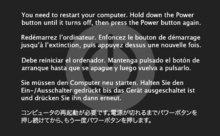Black Screen of Death


The Black Screen of Death (BkSoD[1]) is an error screen displayed by some operating systems after encountering a critical system error which can cause the system to shut down.
The Windows Black Screen of Death
Windows 3.x
In Windows 3.x the black screen of death is the behaviour that occurred when a DOS-based application failed to execute properly. It was often known to occur in connection with attempting certain operations while networking drivers were resident in memory. (Commonly, but not exclusively, it was seen while the Novell NetWare client for DOS, NETX, was loaded.)
According to Wallace McClure of ASP.net, the phrase was originally coined in mid-1991 by Ed Brown, a technician with The Coca-Cola Company's IT department in Atlanta, GA. He reports that the company was rolling out Windows 3.0 within the Global Marketing group and when the users would attempt to run WordPerfect, they would randomly receive a BkSOD.[2]
Later versions of Windows
MS-DOS, Windows 95, Windows 98, Windows 2000, Windows ME, Windows XP, Windows Vista, Windows 7, and Windows 8 also display a Black Screen of Death when the operating system cannot boot. This is usually due to a missing file.[3] This also happens when the user enables file compression on all files and the operating system compresses. Often the user must reinstall Windows, if the missing file is critical to the boot process. However, more often than not the boot screen will inform the user of the missing file. If the operating system is compressed, it will not be able to boot, even into safe mode.[4][5] However, booting from another device and uncompressing the files will usually solve the issue.
In late 2009 several new reports of the Black Screen of Death in Windows XP, Windows Vista, and Windows 7 emerged. At first several claims pointed at a Windows Update. It was later recanted by Prevx as an erroneous report.[6][7] Microsoft reported that no security update was causing the issue, and it may be tied to malware.[8][9] In other cases, the black screen was replaced with the Blue Screen of Death. The Black Screen of Death may also be caused by certain components of a computer overheating.
Early builds of Windows 8 featured a black screen of death, in place of the traditional blue screen, that appeared to indicate a Stop error. This black screen was simplified compared to the previous blue screen, omitting instructions that the user is recommended to take.[10]
See also
References
- ↑ Although the short form BSoD was once used to describe the Black Screen of Death, nowadays the said short form is used to describe the much more common Blue Screen of Death (for Windows) so as to avoid confusion between the Blue and Black Screens of Death.
- ↑ Wallace B. McClure (2004-02-24). "Origin of BSOD". Retrieved 2001-07-10.
- ↑ "How to fix MBR (remove multiple installations) and install Windows 7".
- ↑ "Black Screen on Boot". Support.microsoft.com. 2007-01-19. Retrieved 2012-01-08.
- ↑ "Computer stops responding with a black screen when you start Windows XP". Support.microsoft.com. 2011-02-03. Retrieved 2012-01-08.
- ↑ Erasmus, Jacques (2009-11-30). "Windows Black Screen Root Cause". Prevx.com. Retrieved 2012-01-08.
- ↑ Morris, Mel. "Windows Black Screen recap". Prevx.com. Retrieved 2012-01-08.
- ↑ "'Black screen of death' for some Windows users - Technology & science - Security - msnbc.com". MSNBC. 2012-01-08. Retrieved 2012-01-08.
- ↑ MSRCTeam (2009-12-01). "Reports of Issues with November Security Updates - MSRC - Site Home - TechNet Blogs". Blogs.technet.com. Retrieved 2012-01-08.
- ↑ Tom Warren (24 April 2011). "Microsoft switches to Black Screen Of Death (BSoD) for Windows 8". WinRumors.